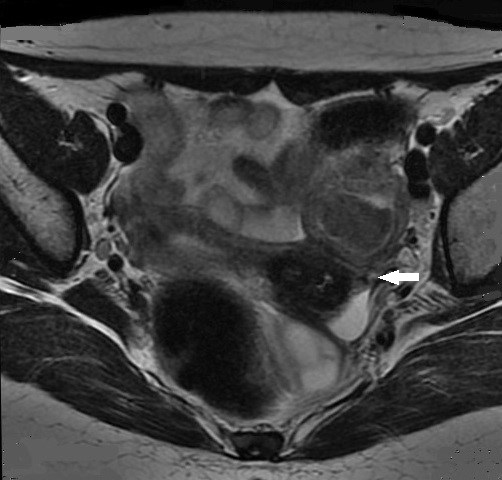Herlyn Werner Wünderlich Syndrome. Presentation of Case and Review of Literature
DOI:
https://doi.org/10.53903/01212095.128Keywords:
Multidetector computed tomography, Magnetic resonance imaging, Mullerian ducts, Female urogenital diseasesAbstract
Herlyn Werner Wünderlich Syndrome is a rare and undiagnosed mullerian malformation, characterized by the triad of clogged hemivagina, ipsilateral renal agenesis and didelphic uterus; its diagnosis is usually late due to the unspecific symptomatology it produces: abdominal pain, dysmenorrhea and palpable abdominal mass secondary to hematocolpos, causing serious changes in fertility. The use of diagnostic images such as ultrasound, tomography and magnetic resonance imaging is essential to diagnose this type of anomaly. The case of a 12-year-old patient with this condition and a review of the literature are presented.
Downloads
References
Al-Jaroudi D, Khan F, Kaddour O, et al. Hysteroscopic resection of vaginal septumunder ultrasound guidance in OHVIRA Syndrome with preservation of hymen. Int JCurr Advanc Res. 2015;4:450-3
Afrashtehfar C, Piña-García A, Afrashtehfar K. Malformaciones müllerianas. Síndromede hemivagina obstruida y anomalía renal ipsilateral (OHVIRA). Cir Cir 2014;82:460-71. doi: https://www.redalyc.org/articulo.oa?id=66231427016
Lewis P, Zarariya A, Daver R, et al. An interesting case report on Herlyn-WernerWunderlich syndrome with hematocolpos and communicating blind duplex ureters.Int J Interdisc Multidisc Stud (IJIMS). 2015;2:163-7. doi: https://www.researchgate.net/publication/285220046
Berni R, Taboada D, Benítez Z. Síndrome de Herlyn Werner Wünderlich. Reporte detres casos. Rev Salud Pública Parag. 2012;2:44-8.
Jaiprakash T, Saxena R, Pandey P. Obstructed hemivagina with ipsilateral renal anomaly (OHVIRA) syndrome - a rare congenital anomaly. J Genit Syst Disor. 2013;2:2-3.doi:10.4172/2325-9728.1000110
Patil B, Mysore R. Uterine didelphys with obstructed hemivagina and ipsilateralrenal anomaly - OHVIRA syndrome: a rare congenital anomaly. Int J Reprod Contracept Obstet Gynecol. 2015;4:889-92. doi: http://dx.doi.org/10.18203/2320-1770.ijrcog20150121
Ahualli J, Méndez L, Ravera M, et al. Síndrome de Herlyn-Werner-Wünderlich: apropósito de un caso. RAR. 2011;75:203-6.
Ozturk H, Dagistan E, Ozlu T. Role of OHVIRA syndrome in renal agenesis: acase report. Ped Urol Case Rep. 2014;1:5-11. doi: http://dx.doi.org/10.14534/PUCR.201424452
Del Vescovo R, Battisti S, Di Paola V, et al. Herlyn-Werner-Wunderlich syndrome:MRI findings, radiological guide (two cases and literature review), and differentialdiagnosis. BMC Medical Imaging. 2012;12:1-10. doi: 10.1186/1471-2342-12-4.
Quintana R, Pinardo A, Calvo M, et al. OHVIRA Syndrome, knowledge and review.Eur Soc Radiol. 2015;1-19. doi: http://dx.doi.org/10.1594/ecr2015/C-152611
Da L, Chou L, Modh M. OHVIRA Syndrome obstructed hemivagina and ipsilateralrenal anomaly and variants. Curr Women’s Health Rev. 2014;10:22-5. doi: 10.2174/157340481001141030090716
Shah D, Laufer M. Obstructed hemivagina and ipsilateral renal anomaly (OHVIRA) syndrome with a single uterus. Fertility Sterility. 2011;96:39-41. https://doi.org/10.1016/j.fertnstert.2011.05.013
Amin M. Uterus didelphys with obstructed hemivagina and ipsilateral renal anomaly(OHVIRA syndrome): A case report. J Ped Surg Case Reports. 2014;410-2. https://doi.org/10.1016/j.epsc.2014.08.009
Salomao P, Doski J. Herlyn-Werner-Wunderlich syndrome: a case report. Rev BrasGinecol Obstet. 2015;37:192-6. https://doi.org/10.1590/SO100-720320150005077
Guillan-Maquieira C, Sánchez J, Méndez J. Síndrome OHVIRA (hemivagina obstruida y anomalía renal ipsilateral) asociado a útero didelfo. Prog Obstet Ginecol.2012;55:281-4. https://doi.org/10.1016/j.pog.2012.02.009
Huete A, Craig J, Vial C, et al. Rol de la imagenología en el proceso diagnóstico dela patología ginecológica benigna. Rev. chil. obstet. ginecol. 2016;81:63-85. http://dx.doi.org/10.4067/S0717-75262016000100011
Benacerraf B, Abuhamad A, Bromley B, et al. Consider ultrasound first for imaging thefemale pelvis. Am J Obstet Gynecol. 2015;212:450-5. doi: https://doi.org/10.1016/j.ajog.2015.02.015
Frutos F, Hijona J, Espejo S, Torres J. Indicaciones de la resonancia magnética en eldiagnóstico ginecológico. Progresos Obstet Ginecol. 2010;53:308-14. doi: 10.1016/j.pog.2009.12.010
Siu A, Vargas V, Murcia F, et al. Síndrome de OHVIRA: características clínicas ycomplicaciones, nuestra experiencia. Cir Pediatr. 2019;32:11-6
Aveiro A, Miranda V, Cabral C, et al. Herlyn-Werner-Wunderlich syndrome: a rarecause of pelvic pain in adolescent girls. BMJ Case Reports. 2011;1-3. doi: 10.1136/bcr.04.2011.4147
Kapoor Y, Sherke A, Sheikh N. OHVIRA Syndrome – A case report. Int J DevelopRes. 2014;4:1919-22.

Downloads
Published
How to Cite
Issue
Section
License

This work is licensed under a Creative Commons Attribution-NonCommercial-ShareAlike 4.0 International License.
La Revista Colombiana de Radiología es de acceso abierto y todos sus artículos se encuentran libre y completamente disponibles en línea para todo público sin costo alguno.
Los derechos patrimoniales de autor de los textos y de las imágenes del artículo como han sido transferidos pertenecen a la Asociación Colombiana de Radiología (ACR). Por tanto para su reproducción es necesario solicitar permisos y se debe hacer referencia al artículo de la Revista Colombiana de Radiología en las presentaciones o artículos nuevos donde se incluyan.







